Leverage Technology to Build Confidence in Any Investor Relationship
One of the questions we get asked frequently by our clients is, “What are private equity best practices and what is everyone else doing that I should be doing?” To answer it, we offer our insightful Private Equity Technology Assessment.
This evaluation is based on the Business Maturity Model, which outlines key components to consider as you invest in and evolve your use of technology within your firm.
The 10-minute questionnaire helps you assess your current technology state. It also enables you to identify priorities for the future, since the industry is continually changing and the firms that succeed are those that stay on the leading edge of the technology wave.
The Altvia Private Equity Technology Assessment looks at five main areas:
1. Technology
2. Data & Analytics
3. People
4. Process
5. Sponsorship
The technology portion focuses on your technology investment and how your use of technology has evolved over time within your firm. Knowing where you’ve been and how you got to where you are today makes it easier to plot a course to where you want to be down the road.
The part of the assessment that covers data and analytics assesses data quality and how you and your team leverage information to drive insightful reporting. Success in private equity today requires that you do more than simply gather data—you have to extract the maximum value from the information you collect and generate.
The area dealing with people evaluates your usage and adoption of technology across the various solutions you use and looks at whether you have people in leadership positions tasked with driving your technology strategy. Obviously, even the most advanced technology is of no value if it’s not being used.
The process portion of our Private Equity Technology Assessment reviews how well your business processes and your technology align. When sound methodologies are supported by the right technology, your teams and the stakeholders they interact with all benefit.
Last but not least, the sponsorship area looks at the involvement of your executive sponsor(s). The oversight and encouragement from people at the top level of an organization are essential to the successful adoption of private equity technology.
For each of the categories, the assessment helps you determine where you stand. Are you in the early stages or “developing”? Have you progressed past “developing” and begun moving toward “emerging”? Or are you even more evolved and considered “strategic”? And for those who are especially progressive, the label “market leading” is applied.
The key with any carefully crafted assessment is that there is no “right” or “wrong” answer. Rather, the results fall somewhere along a continuum. It’s important to understand where you are today with your private equity technology and what changes you can make to better support your business strategy.
In addition, it’s crucial to be aware that there is a symbiotic relationship between and among the five categories in our Private Equity Technology Assessment—improvements you make in any area give a positive boost to the others. So, firms that are market leaders are focusing on all five areas to ensure that they maximize the ROI on their private equity technology.
Why Private Equity Firms Need a Clearly Defined Technology Strategy
The private equity industry is at a technological turning point. Every year, limited partners are demanding faster, easier access to information, while general partners are struggling with how best to use technology to support these critical investor relationships. Savvy investors are now expecting that informative reports and other materials be available via email on-demand or at a particular cadence.
Survey results from an EY Private Equity Study indicate that “more than 65% of firms are currently investing in (or plan to invest in) emerging technologies such as digital data delivery, advanced analytics or robotics.”
Another study from KPMG found that only a handful of larger firms “have already implemented or are currently exploring the use of digital tools and D&A to provide the edge.”
In short, successful private equity firms are increasingly focused on technology transformation and improved investor reporting to meet new demands. Every year, the importance of advanced private equity technology is more widely recognized.
For firms looking to capitalize on private equity technology more effectively in areas like deal flow management, fundraising management, and investor relations communications, having a firm grasp on how well they are leveraging available solutions isn’t a luxury, it’s a necessity.




